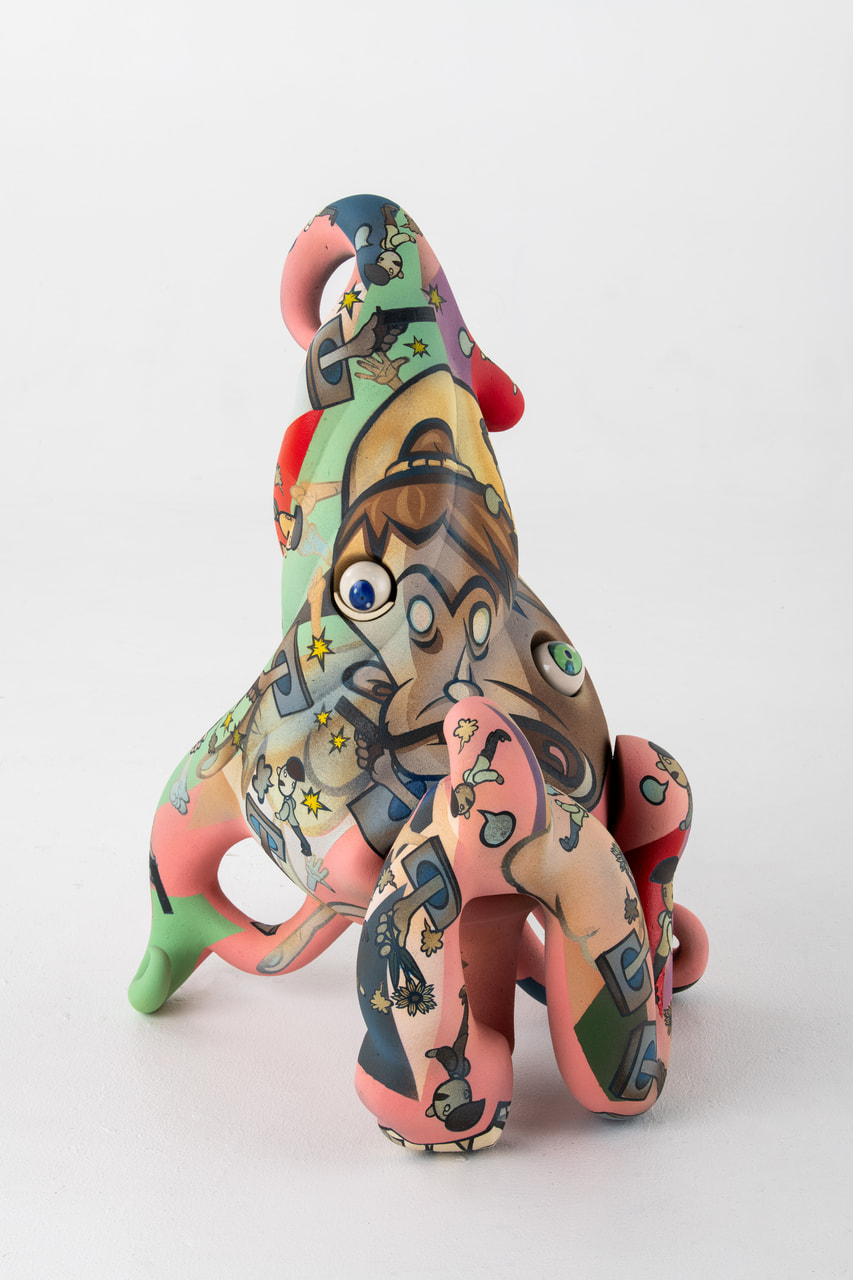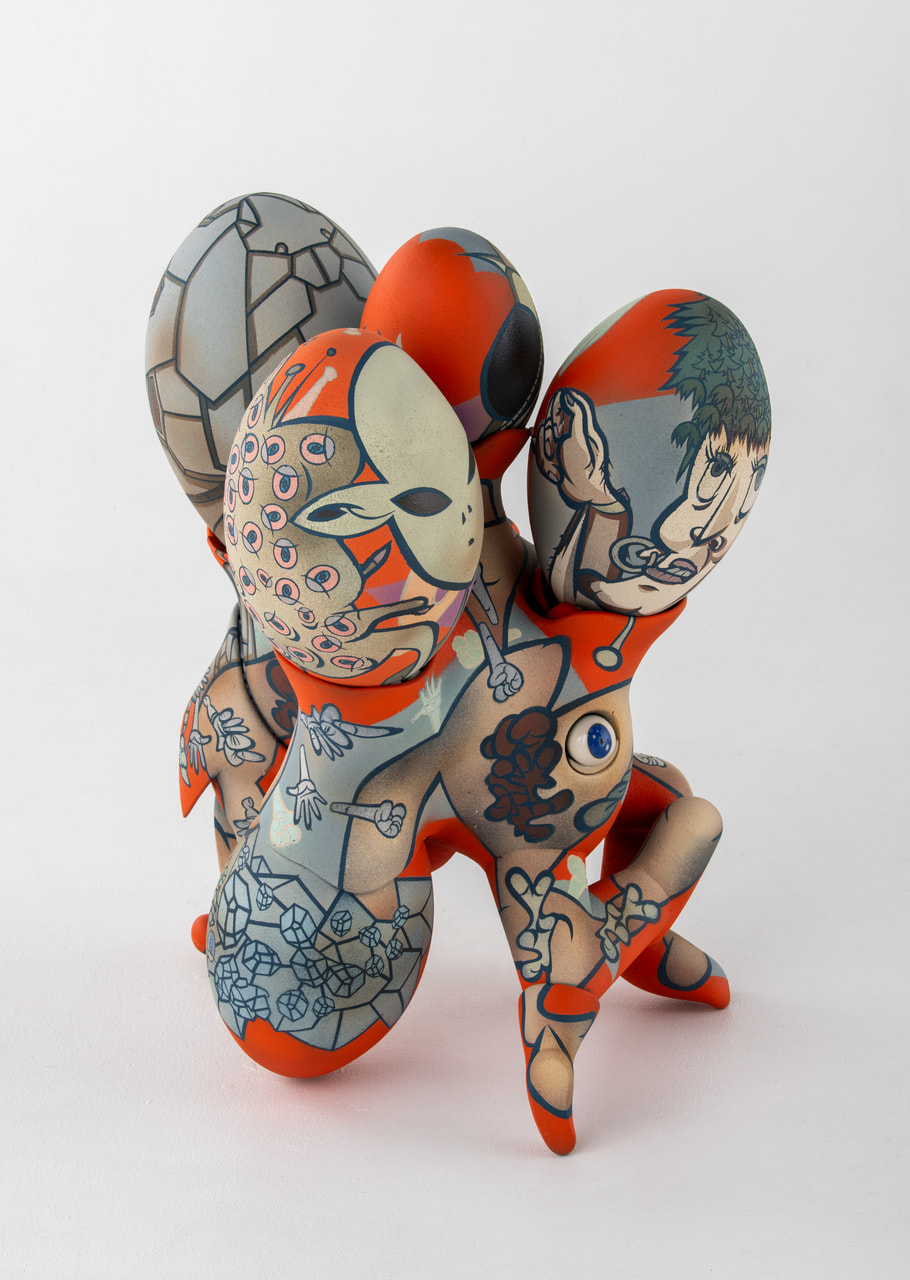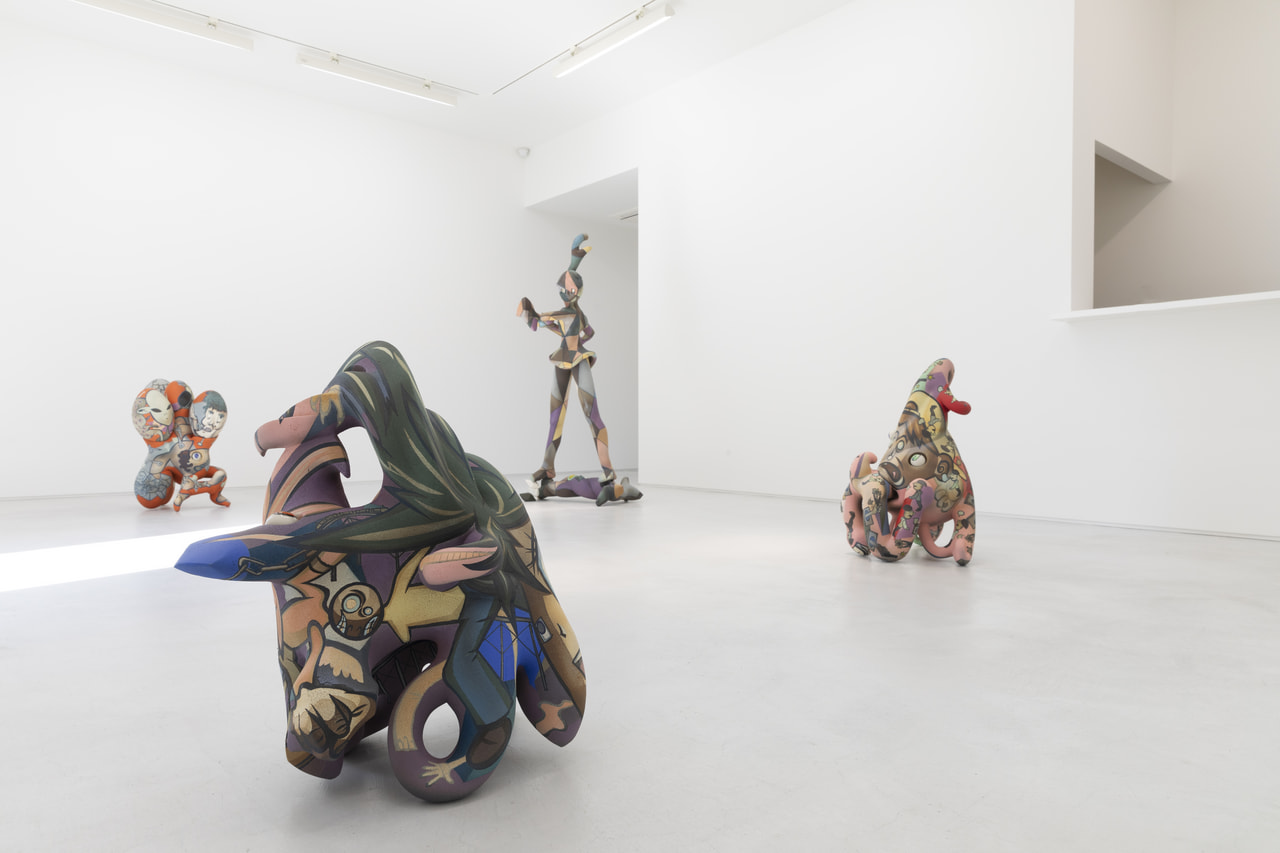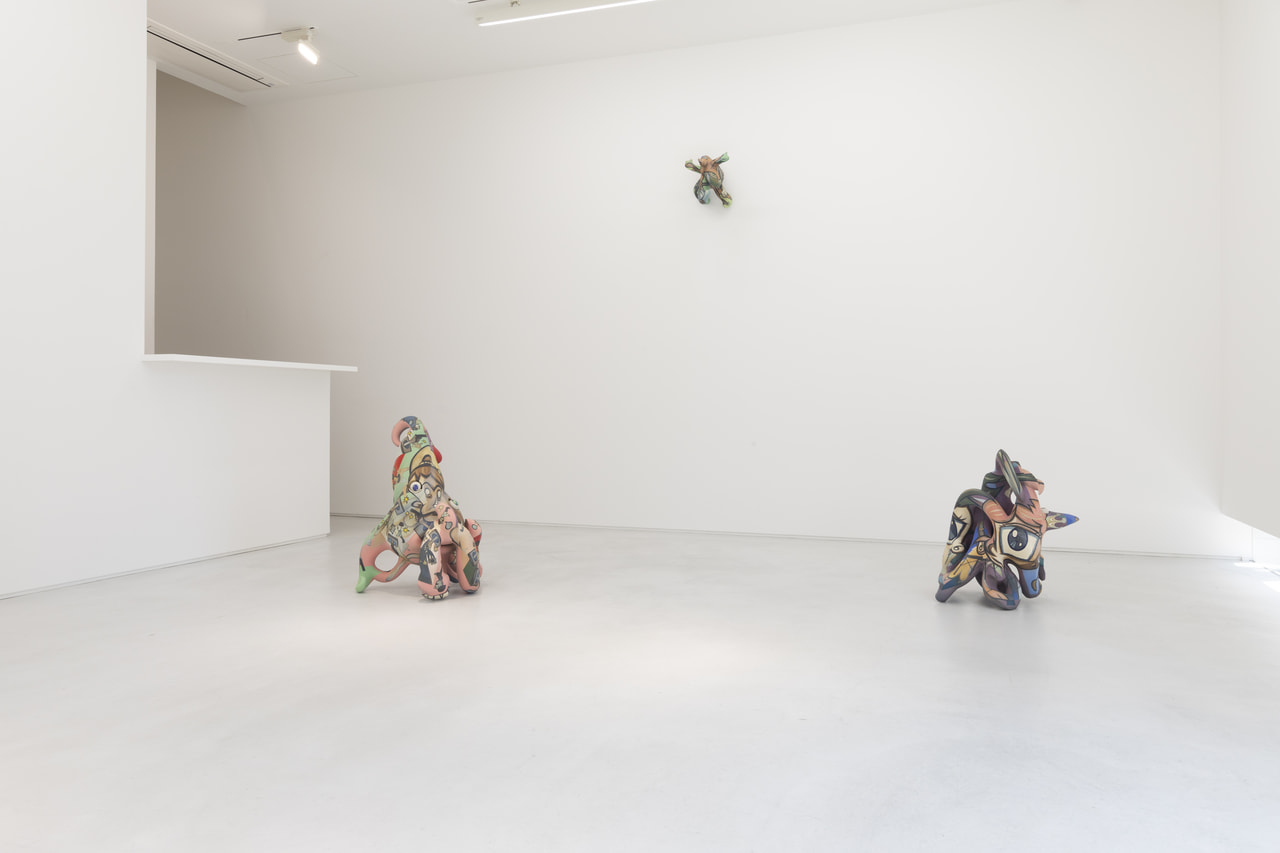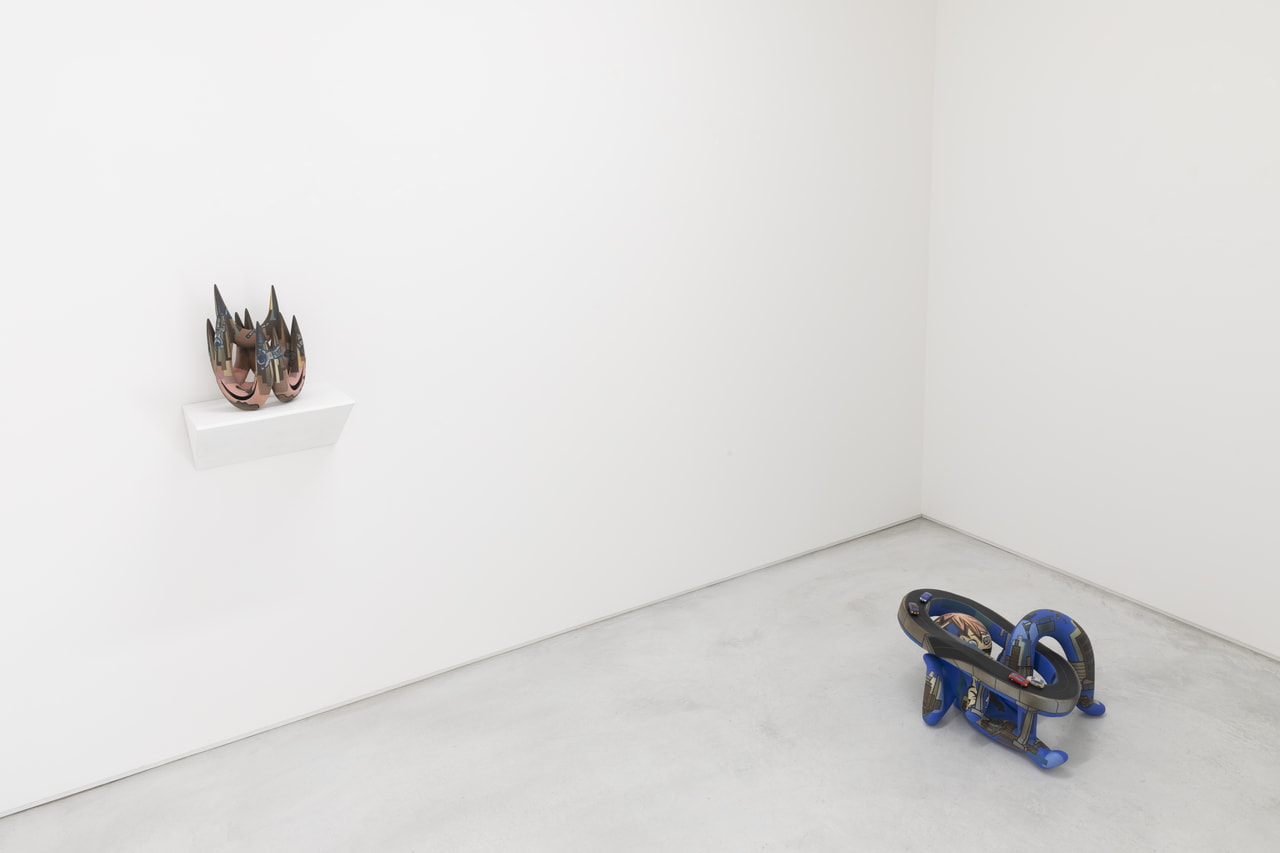An exhibition by shushikikeigaku artist Takashi Hinoda will be presented this autumn at Imura Art Gallery. Hinoda created the term shushikikeigaku [“hand, color, shape, and amusement”] as an alternative to bijutsu [art]. It refers to his creative process with a focus on color and form—arguably the inherent “body” of visual art—using the artist’s hands (body) as the medium.
Hinoda’s creative style involves shaping the clay with his hands, then adding color by spraying ceramic pigment while masking parts of the clay. The work is then fired in an electric kiln, after which it is colored again and then fired once more, the work taking shape as this process is repeated. Also distinctive is the installation-based exhibition space—which he first introduced around 20 years ago—in which the artist’s works are displayed. In addition to the ceramic works on display in the space, Hinoda’ practice has involved covering the floor and walls and at times even the ceiling, with patterned adhesive sheets. The creation of this space is an extension of Hinoda’s ceramic-making process in the sense that it involves the physical act of cutting the adhesive sheet. He has experimented with a number of different approaches to incorporate familiar and everyday “materials” such as tableware and vases into the contemporary art context and space. For this exhibition, however, Hinoda returns to his starting point, taking on the challenge of using the inherent density and solidity of the ceramic object to assert its presence in the white cube that is the gallery space.
Although the surface of the artist’s work provides a base for motifs that appear to be referencing social issues of the day, “the concept” is not the premise of shushikikeigaku. Instead, the intention is for the viewer to enjoy the resonance, movement, and collision of color and form. We hope that visitors will enjoy Takashi Hinoda’s work in the same way that we enjoy sound, smell and taste.
The focus of this exhibition is new work that I featured in my solo show as part of the Taipei Dangdai Art Fair held in May this year.
In contrast to the Taipei show in which the installation incorporated the indiscriminate growth of plants stretching across the walls of the gallery space, this is a simple placement of ceramic sculptures dotted through the space. My intention is for the reverberating power of the lines expanding across the entire exhibition space in previous exhibitions to now be condensed into each individual work and to direct the viewer’s focus to what is contained there.
Clay is distinctive for its solidity and durability, as represented by building materials such as roof tiles, bricks, and other ceramic tiles, while it has a tactility that’s familiar to us all. I have been working with this material for many years, and coming up with a way of creating—within the exhibition setting—a point of contact or distance between the viewer and the work has been a challenge. There is a strong affinity between our body and ceramics, an example being the intimacy of holding the tea bowl in a tea ceremony. On other hand its drawback is that it isn’t a visually assertive material when it comes to visual art; much like an orphan, it struggles to find its place within a vast and empty space.
Having put aside the framework of Art (bijutsu), I created a new field called shushikikeigaku and have been using this term over the last few years to describe my work. Art has held a distinctive position within the context of human labor, but in the last two centuries, this has pivoted and altered so that the focus of art has become the concept, and research. As I attempted to identify exactly what it was that I wanted to create, I began to see that there was still a lot of potential to create something significant by combining the three elements of hands (labor), color and form, and I felt a renewed sense of anticipation. With the rotation of the triangle—the three elements of color, form, and the body that appreciates and embraces them—I am always hoping that the result of creation will reverberate with the sounds of an ambiguous world.
I have, above all else, avoided creating work that is unambiguous or that has a specific narrative. An easily understood narrative to define the world may, in some ways, be comfortable, but at the same time there is a possibility that it could head in an overly simplistic and dangerous direction. That’s why my work is never about providing a direct answer to or making an assertion about current issues. As a result, at first glance my works may seem quite chaotic, but I firmly believe in the potential of these works that, by applying a vertical time axis, attempt to “cut out” aspects of the world that we live in.
Takashi Hinoda
イムラアートギャラリーでは今秋、手色形楽(しゅしきけいがく)の作家・日野田崇による個展を開催いたします。手色形楽とは、日野田によって考案された、「美術」に代わる用語で、造形芸術の元来の「身体」ともいえる色・かたちを作家の手(身体)を媒介にしてつくりだすことに焦点を当てる試みを指します。
日野田の制作スタイルは土を手びねりで形成し、マスキングをしながら陶芸用の顔料を吹き付けて彩色が行われます。電気窯で焼き、再度彩色を施しては、焼く、という作業を繰り返して作品が形づくられていきます。20年ほど前から始めたインスタレーション形式での展示空間づくりも特徴的で、陶作品に加えて、モチーフを模したカッティングシートを床や壁などに張り巡らせ、時には天井にも及びます。この空間づくりは、陶作品を制作する延長としての感覚で、カッティングシートを切るといった身体的な試みにより実践されてきました。食器や花器など、もともと人間と親密な距離で使われていた陶という素材を、現代の美術の空間や文脈に対応させるために、これまで日野田はさまざまなアプローチを試みてきましたが、今回、原点に立ち返り、陶作品単体に内在する密度や重量感でギャラリーの白い箱に拮抗させる試みに挑戦します。
作品の表面にはその時代の社会問題に問いを投げかけるようなモチーフが描かれますが、手色形楽では、まずは概念よりも、色やかたちの響きや動き、ぶつかり合いを楽しむ事が前提とされています。音を楽しむような、匂いや味覚で味わうような感覚で、彼の作品を会場にて楽しんでいただけたら幸いです。
今回の展示作品は、今年の5月に開催されたアートフェア「台北當代」において個展形式で発表した新作を中心とするものです。
今回の展示では、壁面全面に、植物の盲目的な成長のイメージを展開した台北での展示とは対象的に、陶立体のみを点在させる簡素な展示を試みます。これは、これまで空間全体に広げていた線の力の響きを作品の内部に凝縮させて、観る人に一点一点で扱われている内容に集中してもらうための方策です。
瓦や煉瓦、タイルなどのような建材に見られるように、堅牢でありながら、陶の素材感には、触覚的に親しみのある肌を持つという特徴があります。長年、この素材を扱ってきて、問題であったのは、展示される環境で、観客との接点や距離をどうやってつくっていこうかということでした。茶道での茶碗の愛で方を思い起こすとわかりますが、私たちの身体と親和性が高い反面、造形芸術の素材としての視覚的主張に弱く、広大な虚空間では、孤児のように居所を見つけ出すのがなかなか難しいのです。
美術という枠組みを脇において、「手色形楽(しゅしきけいがく)」という領分を立ち上げ、自身の制作を表すために、この数年、この用語を使ってきました。もともと美術は、労働の精華のなかでももっとも特殊な位置付けをされてきたもののひとつですが、この2世紀ほどは概念とリサーチを中心にしたものに偏向し、変化してきました。私は、自身のやりたいことを見極めるなかで、手(労働)と色とかたちの三者の組み合わせでまだまだ何かが生み出せるのでは、とあらためて期待するようになりました。色、かたち、それをつくりだしたり、味わったり受け止めたりする身体、この三つが構成する三角形が廻転していくうちに、多義的な世界の響きが聞こえてくるようなものが生み出せればとつねに考えています。
私の制作は、作品が、一義的な意味や、特定の物語と直結するのを何よりもまず避けるようにしてきました。なぜなら世界を理解のしやすい物語に回収することは、ある種の慰めにはなりますが、同時に大変安易で危険な方向にも転じる可能性があるからです。ですから、いつもは、作品は、直接的に時事的な問題を、何かの答えや断定として扱うことはまずありません。ですので、一見したところ、それらは相当に混沌とした状態に見えるはずですが、その反面、私たちの生きている世界の様相を垂直的な時間軸で切り取ろうとする試みだと強く信じています。
日野田崇
